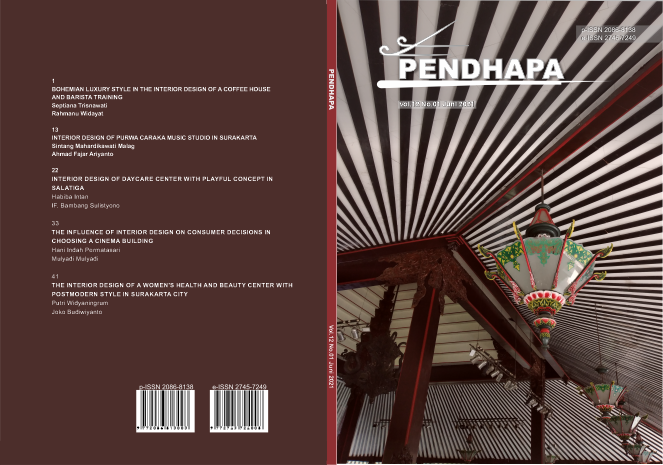Interior Design of Purwa Caraka Music Studio in Surakarta
DOI:
https://doi.org/10.33153/pendhapa.v12i1.3894Keywords:
Interior Design, Purwa Caraka, Music Studio, Contemporary, Pop artAbstract
Purwa Caraka Music Studio is an informal music school that is quite well known in Indonesia, which has 90 branches; one of them is in Surakarta. The Interior Design of Purwa Caraka Music Studio in Surakarta aims to fulfil the users’ activities to be comfortable and safe by implementing health protocols during the pandemic. This design applies the theme rhythm with a contemporary pop art style. Batik Parang Tuding motif is used as a design transformation because it shares the same meaning as Purwa Caraka Music Studio's vision "we teach music better". The design method uses the method of Pamudji Suptandar with data sources from informants, literature, and photos/objects/artefacts. Data collection techniques use structured interview techniques, literature study, and observationDownloads
References
Adams, Cey, Derrick Adams, Chiho Aoshima, Polly Apfelbaum, Richard Anuszkiewicz, Karel Appel, Donald Baechler, Jean Michel Basquiat, Katherine Bernhardt, and Mel Bochner. 2020. “Art for Sale: Vertu Fine Art Art for Sale: Vertu Fine Art.” New Yorker.
Angelidou, Anastasia. 2020. “Pop Art Evolution and Its Impact on Fashion and Product Design.”
Bumgardner, Matthew S, and David L Nicholls. 2020. “Sustainable Practices in Furniture Design: A Literature Study on Customization, Biomimicry, Competitiveness, and Product Communication.” Forests 11 (12): 1277.
Dillon, Lorna. 2020. “Surrealism, Pop Art and Modern Aesthetics in Violeta Parra’s Papier-Mâché Sculptures, Paintings and Embroideries.” In Violeta Parra’s Visual Art, 81–114. Springer.
Elmgren, Heidi. 2021. “Hindrances to Recognition in Finnish Music Schools.” International Journal of Music Education 39 (2): 202–17.
Firanty, F, F Latif, and T Indahyani. 2021. “Interior Design of Music Schools in Jakarta.” In IOP Conference Series: Earth and Environmental Science, 729:12059. IOP Publishing.
González de Armas, Liuba. 2020. “Revolutionary Poster Women: Socialist Realism, Pop Art, and State Rhetoric on Femininity in Cuban Political Graphics, 1961–75.”
Graburn, Nelson H H. 2021. “Introduction: Arts of the Fourth World.” In Ethnic and Tourist Arts, 1–32. University of California Press.
Kaprow, Allan. 2020. “The Artist as a Man of the World (1964).” In Essays on the Blurring of Art and Life, 46–58. University of California Press.
Khakberdiyev, A M, D E Karimova, and F B Tursunboyeva. 2021. “Distinctive Features of Modern Styles in Interior Design.” In “Online-Conferences” Platform, 231–35.
Lucie-Smith, Edward. 2020. Movements in Art Since 1945: (World of Art). Thames & Hudson.
Richards, Greg. 2020. “Designing Creative Places: The Role of Creative Tourism.” Annals of Tourism Research 85: 102922.
Somerville, Kristine. 2021. “Clash: Punk’s Influence on Contemporary Art.” The Missouri Review 44 (1): 133–49.
Tahiroğlu, Koray, and Thor Magnusson. 2021. “Introduction to the Special Issue on Socio-Cultural Role of Technology in Digital Musical Instruments.” Journal of New Music Research 50 (2): 117–20.
Tennent, Kevin D. 2020. “The Age of Strategy: From Drucker and Design to Planning and Porter.” The Palgrave Handbook of Management History, 781–800.
Downloads
Published
Issue
Section
License
Authors who publish with Pendhapa agree to the following terms:
- Authors retain copyright and grant the journal right of first publication with the work simultaneously licensed under a Creative Commons Attribution License (CC BY-SA 4.0) that allows others to share the work with an acknowledgment of the work's authorship and initial publication in this journal.
- Authors are able to enter into separate, additional contractual arrangements for the non-exclusive distribution of the journal's published version of the work (e.g., post it to an institutional repository or publish it in a book), with an acknowledgment of its initial publication in this journal.
- Authors are permitted and encouraged to post their work online (e.g., in institutional repositories or on their website) prior to and during the submission process, as it can lead to productive exchanges, as well as earlier and greater citation of published work.

This work is licensed under a Creative Commons Attribution-ShareAlike 4.0 International License.









